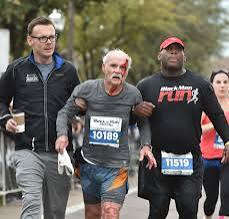Sporting heroes help injured runner make it to the finish line
It’s a widely accepted fact that we’re in the midst of a massive running injury epidemic. Who or what is to blame for this epidemic is a matter of vigorous debate, but there’s no denying that studies of running injuries produce some alarming numbers about how many runners get hurt, with the reported prevalence of injuries as high as 92.4 percent.
I’ve generally accepted this conventional view without questioning it. But in a recent e-mail discussion about the underlying causes of running injuries, my friend and colleague Amby Burfoot offered an alternative perspective that made me rethink whether running really is the most dangerous thing I do every day.
It’s clear that the injury numbers you come up with depend on how you define “injury.” If you have a minor blister, does that count? An ache in your foot that you’re vaguely aware of for a few days but which then disappears with no further consequences? While these things are inconvenient, no one really considers them to be as bad as, say, a stress fracture.
Amby suggested considering the following scenario: If you sign up for a marathon six to eight months in the future, what are the chances you’ll make it through the training program intact, make it to the start line, and finish the race?
In theory, you’d expect to see some pretty gruesome numbers. Marathon training can be far harder on the body than shorter distances, and that’s especially true if you’re a first-time marathoner or a competitive runner seeking a personal record. Given the typical injury numbers found in studies, it would seem like a victory if more than a few dozen people made it to the start of big-city marathons.
Of course, that’s not what actually happens. A few marathons publish statistics on the fate of everyone who












Post Comment